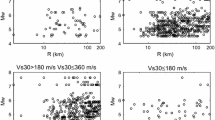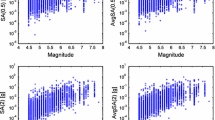Abstract
A new ground-motion prediction equation for 5%-damped horizontal spectral acceleration applicable to Iran is presented. On the basis of analysis of variance (ANOVA), selected West-Eurasian records are added to an existing dataset of Iranian accelerometric data to yield a ground-motion prediction equation applicable at wider ranges of magnitude and distance. The advantages of using this model rather than those proposed previously for Iran are discussed by considering the distribution of residuals against the explanatory variables, magnitude and distance. The applicability of the proposed model, as well as those of several other models developed for shallow crustal environments, is also investigated by means of statistical tools. The results reveal the overall suitability of the new model as well as the validity of models developed using mainly Eurasian strong-motion records.
Similar content being viewed by others
References
Abrahamson NA (2000) State of the practice of seismic hazard evaluation. Earthquake Engineering, GeoEng2000 Conf. Melbourne, Australia
Abrahamson NA (2007) Results and implications of the next generation attenuation (NGA) ground motion project. SMIP07 Seminar on utilization of strong-motion data
Akkar S, Bommer JJ (2006) Influence of long-period filter cut-off on elastic spectral displacements. Earthquake Eng Struct Dyn 35:1145–1165. doi:10.1002/eqe.577
Ambraseys NN, Smit P, Douglas J, Margaris B, Sigbjornsson R, Olafsson S, Suhadolc P, Costa G (2004) Internet-site for European strong-motion data. Boll Geofis Teor Appl 45:113–129
Ambraseys NN, Douglas J, Sarma SK, Smit PM (2005) Equations for the estimation of strong ground motions from shallow crustal earthquakes using data from Europe and the Middle East: horizontal peak ground acceleration and spectral acceleration. Bull Earthq Eng 3:1–53. doi:10.1007/s10518-005-0183-0
Amiri G, Mahdavian A, Manouchehri D (2007) Attenuation relationships for Iran. J Earthqu Eng 11:469–492
Berberian M, Qorashi M, Jackson JA, Priestly K (1992) The Rudbar–Tarom earthquake of 20 June 1990 in new Persia: preliminary field and seismological observations, and its tectonic significance. Bull Seismol Soc Am 82:1726–1755
Berberian M, Jackson JA, Qorashi M, Khatib MM, Priestly K, Talebian M, Ghafuri-Ashtiani M (1999) The 1997 May 10 Zirkuh (Qaenat) earthquake (Mw 7.2): faulting along the Sistan suture zone of eastern Iran. Geophys J Int 136:671–694. doi:10.1046/j.1365-246x.1999.00762.x
Berberian M, Jackson JA, Fielding E, Parsons BE, Priestly K, Qorashi M, Talebian M, Walker R, Wright TJ, Baker C (2001) The 1998 March 14 Fandoqa earthquake (Mw 6.6) in Kerman province, southeast Iran: re-rupture of the 1981 Sirch earthquake fault, triggering of slip on adjacent thrusts and the active tectonics of the Gowk fault zone. Geophys J Int 146:371–398. doi:10.1046/j.1365-246x.2001.01459.x
Beyer K, Bommer JJ (2006) Relationships between median values and between aleatory variables for different definitions of the horizontal component of motion. Bull Seismol Soc Am 96:1512–1522. doi:10.1785/0120050210
Boore DM, Akkar S (2003) Effect of causal and acausal filters on elastic and inelastic response spectra. Earthquake Eng Struct Dyn 32:1729–1748. doi:10.1002/eqe.299
Boore DM, Atkinson GM (2008) Ground-motion prediction equations for the average horizontal component of PGA, PGV, and 5% damped PSA at spectral periods between 0.01 s and 10.0 s. Earthq Spectra 24:99–138. doi:10.1193/1.2830434
Boore DM, Bommer JJ (2005) Processing of strong-motion accelerograms: needs, options and consequences. Soil Dyn Earthqu Eng 25:93-115. doi:10.1016/j.soildyn.2004.10.007
Boore DM, Stephens CD, Joyner WB (2002) Comments on baseline correction of digital strong-motion data: examples from the 1999 Hector Mine, California earthquake. Bull Seismol Soc Am 92:1543–1560. doi:10.1785/0120000926
Boore DM, Watson-Lamprey J, Abrahamson NA (2006) Orientation-independent measures of ground motion. Bull Seismol Soc Am 96:1502–1511. doi:10.1785/0120050209
Campbell KW (1981) Near source attenuation of peak horizontal acceleration. Bull Seismol Soc Am 71:2039–2070
Campbell KW (2002) Engineering models of strong ground motion. In: Chen WF, Scawthorn C (eds) Handbook of earthquake engineering. CRC, Boca Raton, FL, USA, chap. 5
Campbell KW, Bozorgnia Y (2008) NGA ground motion model for the geometric mean horizontal component of PGA, PGV, PGD and 5% damped linear elastic response spectra for periods ranging from 0.01 to 10 s. Earthq Spectra 24:139–171. doi:10.1193/1.2857546
Chiou BS, Youngs RR (2008) An NGA model for the average horizontal component of peak ground motion and response spectra. Earthq Spectra 24:173–215. doi:10.1193/1.2894832
Douglas J (2002) Errata of and additions to ESEE Report No. 01–1: a comprehensive worldwide summary of strong-motion attenuation relationships for peak ground acceleration and spectral ordinates (1969 to 2000). SM Report, Department of Civil and Environmental Engineering, Imperial College, London, October
Douglas J (2003) Earthquake ground motion estimation using strong-motion records: a review of equations for the estimation of peak ground acceleration and response spectral ordinates. Earth Sci Rev 61:43–104. doi:10.1016/S0012-8252(02)00112-5
Douglas J (2004a) An investigation of analysis of variance as a tool for exploring regional differences in strong ground motions. J Seismol 8:485–496. doi:10.1007/s10950-004-3094-7
Douglas J (2004b) Use of analysis of variance for the investigation of regional dependence of strong ground motions. In: Proceedings of 13th European conference on earthquake engineering. Paper reference 330
Douglas J, Smit PM (2001) How accurate can strong ground motion attenuation relations be? Bull Seismol Soc Am 91:1917–1923. doi:10.1785/0120000278
Drouet S, Scherbaum F, Cotton F, Souriau A (2007) Selection and ranking of ground motion models for seismic hazard analysis in the Pyrenees. J Seismol 11:87–100. doi:10.1007/s10950-006-9039-6
Engdahl ER, Jackson J, Myers S, Bergman E (2006) Relocation and assessment of seismicity in the Iran region. Geophys J Int 167:761–778. doi:10.1111/j.1365-246X.2006.03127.x
Fukushima Y (1997) Comment on “Ground motion attenuation relations for subduction zones”. Seismol Res Lett 68:947–949
Fukushima Y, Tanaka T (1990) A new attenuation relationship for peak horizontal acceleration of strong earthquake ground motion in Japan. Bull Seismol Soc Am 80:757–783
Fukushima Y, Irikura K, Uetake T, Matsumoto H (2000) Characteristics of observed peak amplitude for strong ground motion from the 1995 Hyogo-ken Nanbu (Kobe) earthquake. Bull Seismol Soc Am 90:545–565. doi:10.1785/0119990066
Fukushima Y, Berge-Thierry C, Volant P, Pommera D, Cotton F (2003) Attenuation relation for west Eurasia determined with recent near-fault records from California, Japan and Turkey. J Earthqu Eng 7:573–598. doi:10.1142/S1363246903001413
Ghasemi H, Zare M, Fukushima Y, Sinaeian F (2008a) Applying empirical methods in site classification, using response spectral ratio (H/V), a case study on Iranian Strong Motion Network (ISMN). Soil Dyn Earthqu Eng. doi:10.1016/j.soildyn.2008.01.007
Ghasemi H, Zare M, Fukushima Y (2008b) Ranking of several ground motion models for seismic hazard analysis in Iran. J Geophys Eng 5:301–310. doi:10.1088/1742-2132/5/3/006
Hamzehloo H (2005) Determination of causative fault parameters for some recent Iranian earthquakes using near field SH-wave data. J Asian Earth Sci 25:621–628. doi:10.1016/j.jseaes.2004.06.005
Jackson J, Priestly K, Allen M, Berberian M (2002) Active tectonics of the south Caspian basin. Geophys J Int 148:214–245. doi:10.1046/j.1365-246X.2002.01588.x
Japan Road Association (1980) Specifications for highway bridges part V, seismic design. Maruzen Co., LTD
Joyner WB, Boore DM (1981) Peak horizontal acceleration and velocity from strong motion records from the 1979 Imperial Valley, California, earthquake. Bull Seismol Soc Am 71:2011–2038
Joyner WB, Boore DM (1993) Methods for regression analysis of strong-motion data. Bull Seismol Soc Am 83:469–487
Khademi MH (2002) Attenuation of peak and spectral accelerations in the Persian plateau. In: Proceedings of 12th European conference on earthquake engineering. Paper reference 330
Nissen E, Ghorashi M, Jackson J, Parsons B, Talebian M (2007) The 2005 Qeshm Island earthquake (Iran)-alink between buried reverse faulting and surface folding in the Zagros simply folded belt? Geophys J Int 171:326–338. doi:10.1111/j.1365-246X.2007.03514.x
Scherbaum F, Cotton F, Smit P (2004) On the use of response spectral reference data for the selection and ranking of ground-motion models for seismic hazard analysis in regions of moderate seismicity: the case of rock motion. Bull Seismol Soc Am 94:2164–2185. doi:10.1785/0120030147
Scherbaum F, Bommer JJ, Bungum H, Cotton F, Abrahamson NA (2005) Composite ground-motion models and logic trees: methodology, sensitivities, and uncertainties. Bull Seismol Soc Am 95:1575–1593. doi:10.1785/0120040229
Sinaiean F (2006) Study on Iran strong motion records. Ph.D. Thesis, International Institute of Earthquake Engineering and Seismology, Tehran, Iran
Talebian M, Fielding EJ, Gareth JF, Ghorashi M, Jackson J, Nazari H, Parsons B, Priestly K, Rosen PA, Walker R, Wright TJ (2004) The 2003 Bam (Iran) earthquake: rupture of a blind strike–slip fault. Geophys J Int 31:L11611
Talebian M, Biggs J, Bolourchi M, Copley A, Ghassemi A, Ghorashi M, Hollingsworth J, Jackson J, Nissen E, Oveisi B, Parsons B, Priestly K, Saiidi A (2006) The Dahuiyeh (Zarand) earthquake of 2005 February 22 in central Iran: reactivation of an intramountain reverse fault. Geophys J Int 164:137–148. doi:10.1111/j.1365-246X.2005.02839.x
Tatar M, Jackson J, Hatzfeld D, Bergman E (2007) The 2004 May 28 Baladeh earthquake (Mw 6.2) in the Alborz, Iran: overthrusting the South Caspian Basin margin, partitioning of oblique convergence and the seismic hazard of Tehran. Geophys J Int 170:249–261. doi:10.1111/j.1365-246X.2007.03386.x
Walker R, Jackson J, Baker C (2003) Surface expression of thrust faulting in eastern Iran:source parameters and surface deformation of the 1978 Tabas and 1968 Ferdows earthquake sequences. Geophys J Int 152:749–765. doi:10.1046/j.1365-246X.2003.01886.x
Walker R, Bergman E, Jackson J, Ghorashi M, Talebian M (2005) The 2002 June 22 Changureh (Avaj) earthquake in Qazvin province, northwest Iran: epicentral relocation, source parameters, surface deformation and geomorphology. Geophys J Int 160:707–720. doi:10.1111/j.1365-246X.2005.02516.x
Zaré M (1999) Conribution à l’étude des mouvements forts en Iran: du Catalogue aux lois d’atténuation. Thése de Doctorat (PhD Thesis), Université Joseph Fourier, Grenoble, France
Author information
Authors and Affiliations
Corresponding author
Electronic Supplementary Material
Below is the linked to the Electronic supplementary material.
Rights and permissions
About this article
Cite this article
Ghasemi, H., Zare, M., Fukushima, Y. et al. An empirical spectral ground-motion model for Iran. J Seismol 13, 499–515 (2009). https://doi.org/10.1007/s10950-008-9143-x
Received:
Accepted:
Published:
Issue Date:
DOI: https://doi.org/10.1007/s10950-008-9143-x




